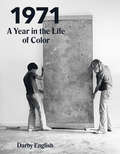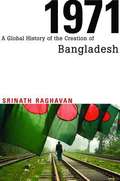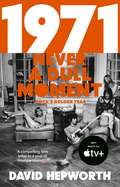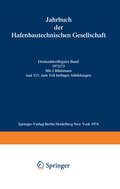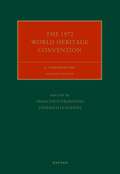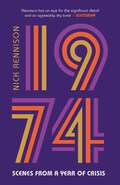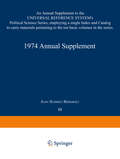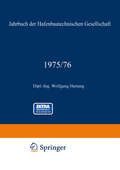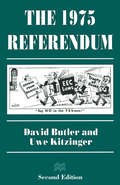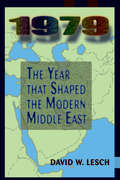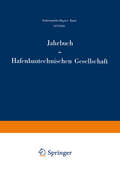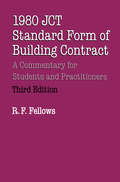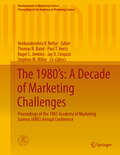- Table View
- List View
1971: A Year in the Life of Color
by Darby EnglishIn this book, art historian Darby English explores the year 1971, when two exhibitions opened that brought modernist painting and sculpture into the burning heart of United States cultural politics: Contemporary Black Artists in America, at the Whitney Museum of American Art, and The DeLuxe Show, a racially integrated abstract art exhibition presented in a renovated movie theater in a Houston ghetto. 1971: A Year in the Life of Color looks at many black artists’ desire to gain freedom from overt racial representation, as well as their efforts—and those of their advocates—to further that aim through public exhibition. Amid calls to define a “black aesthetic,” these experiments with modernist art prioritized cultural interaction and instability. Contemporary Black Artists in America highlighted abstraction as a stance against normative approaches, while The DeLuxe Show positioned abstraction in a center of urban blight. The importance of these experiments, English argues, came partly from color’s special status as a cultural symbol and partly from investigations of color already under way in late modern art and criticism. With their supporters, black modernists—among them Peter Bradley, Frederick Eversley, Alvin Loving, Raymond Saunders, and Alma Thomas—rose above the demand to represent or be represented, compromising nothing in their appeals for interracial collaboration and, above all, responding with optimism rather than cynicism to the surrounding culture’s preoccupation with color.
1971: A Year in the Life of Color
by Darby EnglishIn this book, art historian Darby English explores the year 1971, when two exhibitions opened that brought modernist painting and sculpture into the burning heart of United States cultural politics: Contemporary Black Artists in America, at the Whitney Museum of American Art, and The DeLuxe Show, a racially integrated abstract art exhibition presented in a renovated movie theater in a Houston ghetto. 1971: A Year in the Life of Color looks at many black artists’ desire to gain freedom from overt racial representation, as well as their efforts—and those of their advocates—to further that aim through public exhibition. Amid calls to define a “black aesthetic,” these experiments with modernist art prioritized cultural interaction and instability. Contemporary Black Artists in America highlighted abstraction as a stance against normative approaches, while The DeLuxe Show positioned abstraction in a center of urban blight. The importance of these experiments, English argues, came partly from color’s special status as a cultural symbol and partly from investigations of color already under way in late modern art and criticism. With their supporters, black modernists—among them Peter Bradley, Frederick Eversley, Alvin Loving, Raymond Saunders, and Alma Thomas—rose above the demand to represent or be represented, compromising nothing in their appeals for interracial collaboration and, above all, responding with optimism rather than cynicism to the surrounding culture’s preoccupation with color.
1971: A Year in the Life of Color
by Darby EnglishIn this book, art historian Darby English explores the year 1971, when two exhibitions opened that brought modernist painting and sculpture into the burning heart of United States cultural politics: Contemporary Black Artists in America, at the Whitney Museum of American Art, and The DeLuxe Show, a racially integrated abstract art exhibition presented in a renovated movie theater in a Houston ghetto. 1971: A Year in the Life of Color looks at many black artists’ desire to gain freedom from overt racial representation, as well as their efforts—and those of their advocates—to further that aim through public exhibition. Amid calls to define a “black aesthetic,” these experiments with modernist art prioritized cultural interaction and instability. Contemporary Black Artists in America highlighted abstraction as a stance against normative approaches, while The DeLuxe Show positioned abstraction in a center of urban blight. The importance of these experiments, English argues, came partly from color’s special status as a cultural symbol and partly from investigations of color already under way in late modern art and criticism. With their supporters, black modernists—among them Peter Bradley, Frederick Eversley, Alvin Loving, Raymond Saunders, and Alma Thomas—rose above the demand to represent or be represented, compromising nothing in their appeals for interracial collaboration and, above all, responding with optimism rather than cynicism to the surrounding culture’s preoccupation with color.
1971: A Year in the Life of Color
by Darby EnglishIn this book, art historian Darby English explores the year 1971, when two exhibitions opened that brought modernist painting and sculpture into the burning heart of United States cultural politics: Contemporary Black Artists in America, at the Whitney Museum of American Art, and The DeLuxe Show, a racially integrated abstract art exhibition presented in a renovated movie theater in a Houston ghetto. 1971: A Year in the Life of Color looks at many black artists’ desire to gain freedom from overt racial representation, as well as their efforts—and those of their advocates—to further that aim through public exhibition. Amid calls to define a “black aesthetic,” these experiments with modernist art prioritized cultural interaction and instability. Contemporary Black Artists in America highlighted abstraction as a stance against normative approaches, while The DeLuxe Show positioned abstraction in a center of urban blight. The importance of these experiments, English argues, came partly from color’s special status as a cultural symbol and partly from investigations of color already under way in late modern art and criticism. With their supporters, black modernists—among them Peter Bradley, Frederick Eversley, Alvin Loving, Raymond Saunders, and Alma Thomas—rose above the demand to represent or be represented, compromising nothing in their appeals for interracial collaboration and, above all, responding with optimism rather than cynicism to the surrounding culture’s preoccupation with color.
1971: A Global History Of The Creation Of Bangladesh
by Srinath RaghavanThe war of 1971 that created Bangladesh was the most significant geopolitical event in the Indian subcontinent since partition in 1947. It tilted the balance of power between India and Pakistan steeply in favor of India. Srinath Raghavan contends that the crisis and its cast of characters can be understood only in a wider international context.
1971: A Global History Of The Creation Of Bangladesh
by Srinath RaghavanThe war of 1971 that created Bangladesh was the most significant geopolitical event in the Indian subcontinent since partition in 1947. It tilted the balance of power between India and Pakistan steeply in favor of India. Srinath Raghavan contends that the crisis and its cast of characters can be understood only in a wider international context.
1971 - Never a Dull Moment: Rock's Golden Year
by David HepworthThe Sixties ended a year late – on New Year's Eve 1970, when Paul McCartney initiated proceedings to wind up The Beatles. Music would never be the same again.The next day would see the dawning of a new era. 1971 saw the release of more monumental albums than any year before or since and the establishment of a pantheon of stars to dominate the next forty years – Led Zeppelin, David Bowie, the Rolling Stones, Pink Floyd, Marvin Gaye, Carole King, Joni Mitchell, Rod Stewart, the solo Beatles and more.January that year fired the gun on an unrepeatable surge of creativity, technological innovation, blissful ignorance, naked ambition and outrageous good fortune. By December rock had exploded into the mainstream. How did it happen? This book tells you how. It's the story of 1971, rock’s golden year.
The 1972 World Heritage Convention: A Commentary (Oxford Commentaries on International Cultural Heritage Law)
by Prof Francesco Francioni Prof Federico LenzeriniAlmost fifty years have passed since the adoption of the Convention Concerning the Protection of the World Cultural and Natural Heritage (the UNESCO World Heritage Convention). With its 194 States Parties, it is the most widely ratified convention within the family of UNESCO treaties on the protection of cultural heritage. The success of this Convention and its almost universal acceptance by the international community of states is due to the great appeal that recognising certain properties as “world heritage” has for national governments. Since the publication of the first Commentary, new problems have arisen in the management of world heritage sites. It has become increasingly difficult to properly monitor the conservation of the ever-growing mass of sites inscribed in the World Heritage List, and to resolve disputes over the formal designation of contested world heritage properties - a problem that has led to the withdrawal of the United States and Israel from UNESCO. New frontiers are now being explored for the expansion of the world heritage idea over marine areas beyond national jurisdiction, and the monopoly of the State in the identification, delineation, and presentation of world heritage properties is being increasingly challenged in the name of indigenous peoples' rights and by local communities claiming ownership over contested cultural sites. At the same time, the regime of world heritage protection has infiltrated other areas of international law, especially international economic law, investment arbitration, and the area of international criminal law. This second edition critically examines the World Heritage Convention against this dynamic evolution of international heritage law to help academics, lawyers, diplomats, and officials interpret and apply the norms of the Convention after half a century of uninterrupted implementing practice by State Parties and Treaty Bodies.
The 1972 World Heritage Convention: A Commentary (Oxford Commentaries on International Cultural Heritage Law)
by Prof Francesco Francioni Prof Federico LenzeriniAlmost fifty years have passed since the adoption of the Convention Concerning the Protection of the World Cultural and Natural Heritage (the UNESCO World Heritage Convention). With its 194 States Parties, it is the most widely ratified convention within the family of UNESCO treaties on the protection of cultural heritage. The success of this Convention and its almost universal acceptance by the international community of states is due to the great appeal that recognising certain properties as “world heritage” has for national governments. Since the publication of the first Commentary, new problems have arisen in the management of world heritage sites. It has become increasingly difficult to properly monitor the conservation of the ever-growing mass of sites inscribed in the World Heritage List, and to resolve disputes over the formal designation of contested world heritage properties - a problem that has led to the withdrawal of the United States and Israel from UNESCO. New frontiers are now being explored for the expansion of the world heritage idea over marine areas beyond national jurisdiction, and the monopoly of the State in the identification, delineation, and presentation of world heritage properties is being increasingly challenged in the name of indigenous peoples' rights and by local communities claiming ownership over contested cultural sites. At the same time, the regime of world heritage protection has infiltrated other areas of international law, especially international economic law, investment arbitration, and the area of international criminal law. This second edition critically examines the World Heritage Convention against this dynamic evolution of international heritage law to help academics, lawyers, diplomats, and officials interpret and apply the norms of the Convention after half a century of uninterrupted implementing practice by State Parties and Treaty Bodies.
1973 Nervous Breakdown: Watergate, Warhol, and the Birth of Post-Sixties America
by Andreas Killen1973 marked the end of the 1960s and the birth of a new cultural sensibility. A year of shattering political crisis, 1973 was defined by defeat in Vietnam, Roe v. Wade, the oil crisis and the Watergate hearings. It was also a year of remarkable creative ferment. From landmark movies such as The Exorcist, Mean Streets, and American Graffiti to seminal books such as Fear of Flying and Gravity's Rainbow, from the proto-punk band the New York Dolls to the first ever reality TV show, The American Family, the cultural artifacts of the year reveal a nation in the middle of a serious identity crisis. 1973 Nervous Breakdown offers a fever chart of a year of uncertainty and change, a year in which post-war prosperity crumbled and modernism gave way to postmodernism in a lively and revelatory analysis of one of the most important periods in the second half of the 20th century.
1974 Annual Supplement: An Annual Supplement to the UNIVERSAL REFERENCE SYSTEM’s Political Science Series, employing a single Index and Catalog to carry materials pertaining to the ten basic volumes in the series (The Universal Reference System)
by Joan Schmitz Bergholt1975/76 (Jahrbuch der Hafenbautechnischen Gesellschaft #35)
by Erster Baudirektor Arved Bolle Reinhart KühnThe 1975 Referendum
by David Butler Uwe KitzingerThe holding of referendums has returned to the British political agenda. The re-issue of the story of what happened in the country's only nationwide referendum so far is therefore timely. This book tells the full story of the politics, high and low, as well as the innovative campaigning and administration involved in a key event in United Kingdom history.
1979: The Year That Shaped The Modern Middle East
by David W. LeschThe Israeli-Palestinian peace process, the continuing US-Iraqi confrontation, the changing political dynamics in Iran, recent Pakistani-Indian hostilities and Osama bin Laden-all of these have one important common denominator: Significant strands of their origins can be traced to the tumultuous year of 1979. This text offers a new paradigm for stud
1979: The Year That Shaped The Modern Middle East
by David W. LeschThe Israeli-Palestinian peace process, the continuing US-Iraqi confrontation, the changing political dynamics in Iran, recent Pakistani-Indian hostilities and Osama bin Laden-all of these have one important common denominator: Significant strands of their origins can be traced to the tumultuous year of 1979. This text offers a new paradigm for stud
1980 JCT Standard Form of Building Contract: A Commentary for Students and Practitioners (Building and Surveying Series)
by Richard FellowsThis book analyses and comments on the 1980 JCT Standard Form of Building Contract, Private with Quantities Edition on a clause-by-clause basis, including notes on interpretation, legal precedents and information on the alternative editions of the Standard Form as well as the appropriate supplements. The third edition of this book incorporates the amendments published up to the end of November 1994 and updates the case law to include significant, recent precedents which supplement those included in the first two editions. Thus, this book will prove of use to many concerned with building, whether in industry or the professions commonly encountering problems of interpretation and implementation of the contract, or as students. The use of this book is recommended to be in conjunction with a copy of the appropriate JCT contract in order that the exact terminology of the document may be studied together with its interpretation. This is particularly important in practical situations where amendments to the contract vary the standard terms.
The 1980 Presidential Election: Ronald Reagan and the Shaping of the American Conservative Movement (Critical Moments in American History)
by Jeffrey D. HowisonRonald Reagan’s victory in the 1980 presidential election marked a watershed moment in the history of the United States, heralding the triumph of the American conservative movement. Once a supporter of the New Deal, Reagan had come to symbolize the union of three diverse forms of conservatism—anti-communism, social traditionalism, and libertarianism—that were increasingly intertwined under the banner of the Republican Party. The unlikely development of this new conservative coalition was based upon the larger impacts of the civil rights movement in reshaping the dynamics of the Democratic and Republican parties, the social "backlash" of the Nixon era, the emergence of the religious right, and the economic and political crises that directly set the stage for Reagan’s stunning victory. In five original, engaging chapters, The 1980 Presidential Election shows how Reagan’s journey to the White House was connected to the wider transformations of post-1945 American history. Supplemented by a fresh collection of primary documents—including previously unpublished transcripts of Reagan’s radio addresses of the late-1970s—this book is an ideal introduction to the origins and impact of the American conservative movement.
The 1980 Presidential Election: Ronald Reagan and the Shaping of the American Conservative Movement (Critical Moments in American History)
by Jeffrey D. HowisonRonald Reagan’s victory in the 1980 presidential election marked a watershed moment in the history of the United States, heralding the triumph of the American conservative movement. Once a supporter of the New Deal, Reagan had come to symbolize the union of three diverse forms of conservatism—anti-communism, social traditionalism, and libertarianism—that were increasingly intertwined under the banner of the Republican Party. The unlikely development of this new conservative coalition was based upon the larger impacts of the civil rights movement in reshaping the dynamics of the Democratic and Republican parties, the social "backlash" of the Nixon era, the emergence of the religious right, and the economic and political crises that directly set the stage for Reagan’s stunning victory. In five original, engaging chapters, The 1980 Presidential Election shows how Reagan’s journey to the White House was connected to the wider transformations of post-1945 American history. Supplemented by a fresh collection of primary documents—including previously unpublished transcripts of Reagan’s radio addresses of the late-1970s—this book is an ideal introduction to the origins and impact of the American conservative movement.
The 1980’s: Proceedings of the 1981 Academy of Marketing Science (AMS) Annual Conference (Developments in Marketing Science: Proceedings of the Academy of Marketing Science)
by Thomas R. Baird Paul T. Hertz Roger L. Jenkins Jay D. Linquist Stephen W. MillerThis volume includes the full proceedings from the 1981 Academy of Marketing Science (AMS) Annual Conference held in Miami Beach, Florida with the theme The 1980’s: A Decade of Marketing Challenges. It provides a variety of quality research in the fields of marketing theory and practice in areas such as consumer behaviour, marketing management, marketing education, industrial marketing, and international marketing, among others. Founded in 1971, the Academy of Marketing Science is an international organization dedicated to promoting timely explorations of phenomena related to the science of marketing in theory, research, and practice. Among its services to members and the community at large, the Academy offers conferences, congresses and symposia that attract delegates from around the world. Presentations from these events are published in this Proceedings series, which offers a comprehensive archive of volumes reflecting the evolution of the field. Volumes deliver cutting-edge research and insights, complimenting the Academy’s flagship journals, the Journal of the Academy of Marketing Science (JAMS) and AMS Review. Volumes are edited by leading scholars and practitioners across a wide range of subject areas in marketing science.
A 1980s Childhood: From He-Man to Shell Suits
by Michael A JohnsonDo you remember trying to solve the Rubik’s cube whilst dressed in your He-Man picture pyjamas? Did you try to make ‘cool’ sound effects with your mouth like Jones from Police Academy? Or maybe you swooned over Scott and Charlene’s (aka Jason and Kylie’s) wedding of the year? If that sounds like you, there’s no mistaking you were a child of the eighties. Rev up your DeLorean, switch on the Flux Capacitor and take a cruise back through the decade that made you the person you are today. This amusing and entertaining collection of reminiscences will jog the memories of all who grew up in the same decade where greed was good, mullets were cool and white dog poo littered the streets.
1981 New England Section Topical Meeting on Nonoxide Ceramics (Ceramic Engineering and Science Proceedings #26)
by William J. SmothersThis volume is part of the Ceramic Engineering and Science Proceeding (CESP) series. This series contains a collection of papers dealing with issues in both traditional ceramics (i.e., glass, whitewares, refractories, and porcelain enamel) and advanced ceramics. Topics covered in the area of advanced ceramic include bioceramics, nanomaterials, composites, solid oxide fuel cells, mechanical properties and structural design, advanced ceramic coatings, ceramic armor, porous ceramics, and more.
